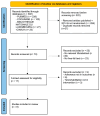Pulmonary Telerehabilitation in COPD Patients: A Systematic Review to Analyse Patients' Adherence
- PMID: 40805851
- PMCID: PMC12346524
- DOI: 10.3390/healthcare13151818
Pulmonary Telerehabilitation in COPD Patients: A Systematic Review to Analyse Patients' Adherence
Abstract
Introduction: Limited access to pulmonary rehabilitation (PR) has contributed to the rise of telerehabilitation (TPR) for COPD patients. Positive comparable effects are observed in exercise tolerance, quality of life (QoL), and dyspnoea with TPR. However, patient adherence to TPR is an outcome that has not been sufficiently analysed. Objective: To analyse adherence, satisfaction, and quality-of-life improvements in COPD patients following the TPR program to determine whether telerehabilitation is comparable to conventional therapy or usual care. Methods: A systematic search was conducted using four electronic databases, retrieving 392 articles. Two independent researchers selected and evaluated these articles based on predefined eligibility criteria. A third researcher was consulted in the event of disagreements. Results: Primary outcomes: Adherence to PR and/or usual care showed a minimum reported value of 62% and a maximum reported value of 91%, while TPR adherence had the lowest reported value of 21% and the highest reported value of 93.5%. Five articles compared TPR to PR and/or usual care, showing that TPR adherence is higher or similar to other interventions, whereas only one article found lower TPR adherence compared to PR. Secondary outcomes: A higher number of dropouts were reported for PR and usual care compared to TPR. Three publications analysed satisfaction and demonstrated that patients are satisfied across groups. Tertiary outcomes: Comparable improvements in QoL were found for TPR and PR, both being superior to usual care. Conclusions: This systematic review reveals heterogeneity in classifying adherence for pulmonary rehabilitation and telerehabilitation. Adherence classification may be standardised in future studies for consistent analysis.
Keywords: pulmonary rehabilitation; quality of life; telerehabilitation.
Conflict of interest statement
The authors declare no conflicts of interest.
Figures
Similar articles
-
Supervised maintenance programmes following pulmonary rehabilitation compared to usual care for chronic obstructive pulmonary disease.Cochrane Database Syst Rev. 2021 Aug 17;8(8):CD013569. doi: 10.1002/14651858.CD013569.pub2. Cochrane Database Syst Rev. 2021. PMID: 34404111 Free PMC article.
-
Pulmonary rehabilitation for chronic obstructive pulmonary disease.Cochrane Database Syst Rev. 2015 Feb 23;2015(2):CD003793. doi: 10.1002/14651858.CD003793.pub3. Cochrane Database Syst Rev. 2015. PMID: 25705944 Free PMC article.
-
Home treatment for mental health problems: a systematic review.Health Technol Assess. 2001;5(15):1-139. doi: 10.3310/hta5150. Health Technol Assess. 2001. PMID: 11532236
-
[Volume and health outcomes: evidence from systematic reviews and from evaluation of Italian hospital data].Epidemiol Prev. 2013 Mar-Jun;37(2-3 Suppl 2):1-100. Epidemiol Prev. 2013. PMID: 23851286 Italian.
-
Falls prevention interventions for community-dwelling older adults: systematic review and meta-analysis of benefits, harms, and patient values and preferences.Syst Rev. 2024 Nov 26;13(1):289. doi: 10.1186/s13643-024-02681-3. Syst Rev. 2024. PMID: 39593159 Free PMC article.
References
-
- Li H.Y., Gao T.Y., Fang W., Xian C.Y., Deng N.J., Zhang C., Niu Y. Global, regional and national burden of chronic obstructive pulmonary disease over a 30-year period: Estimates from the 1990 to 2019 Global Burden of Disease Study. Respirology. 2023;28:29–36. doi: 10.1111/resp.14349. - DOI - PMC - PubMed
-
- Boers E., Barrett M., Su J.G., Benjafield A.V., Sinha S., Kaye L., Zar H.J., Vuong V., Tellez D., Gondalia R., et al. Global Burden of Chronic Obstructive Pulmonary Disease Through 2050. [(accessed on 4 January 2025)];JAMA Netw. Open. 2023 6:e2346598. doi: 10.1001/jamanetworkopen.2023.46598. Available online: https://pubmed.ncbi.nlm.nih.gov/38060225/ - DOI - PMC - PubMed
Publication types
LinkOut - more resources
Full Text Sources
Research Materials


